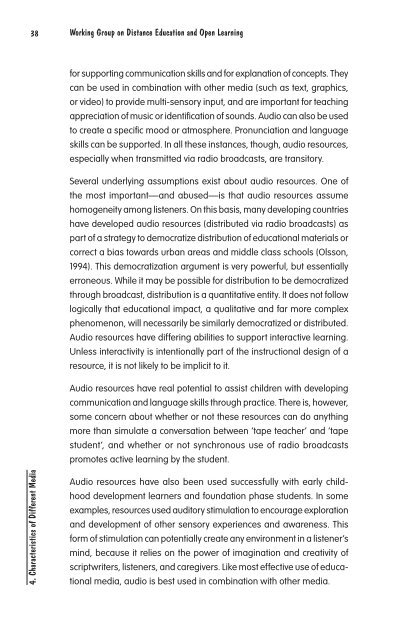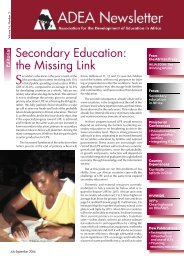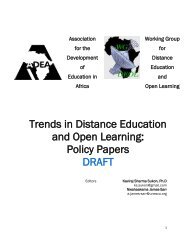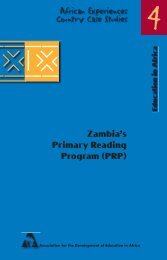Technological Infrastructure and Use of ICT in Education in ... - ADEA
Technological Infrastructure and Use of ICT in Education in ... - ADEA
Technological Infrastructure and Use of ICT in Education in ... - ADEA
Create successful ePaper yourself
Turn your PDF publications into a flip-book with our unique Google optimized e-Paper software.
38 Work<strong>in</strong>g Group on Distance <strong>Education</strong> <strong>and</strong> Open Learn<strong>in</strong>g<br />
for support<strong>in</strong>g communication skills <strong>and</strong> for explanation <strong>of</strong> concepts. They<br />
can be used <strong>in</strong> comb<strong>in</strong>ation with other media (such as text, graphics,<br />
or video) to provide multi-sensory <strong>in</strong>put, <strong>and</strong> are important for teach<strong>in</strong>g<br />
appreciation <strong>of</strong> music or identification <strong>of</strong> sounds. Audio can also be used<br />
to create a specific mood or atmosphere. Pronunciation <strong>and</strong> language<br />
skills can be supported. In all these <strong>in</strong>stances, though, audio resources,<br />
especially when transmitted via radio broadcasts, are transitory.<br />
Several underly<strong>in</strong>g assumptions exist about audio resources. One <strong>of</strong><br />
the most important—<strong>and</strong> abused—is that audio resources assume<br />
homogeneity among listeners. On this basis, many develop<strong>in</strong>g countries<br />
have developed audio resources (distributed via radio broadcasts) as<br />
part <strong>of</strong> a strategy to democratize distribution <strong>of</strong> educational materials or<br />
correct a bias towards urban areas <strong>and</strong> middle class schools (Olsson,<br />
1994). This democratization argument is very powerful, but essentially<br />
erroneous. While it may be possible for distribution to be democratized<br />
through broadcast, distribution is a quantitative entity. It does not follow<br />
logically that educational impact, a qualitative <strong>and</strong> far more complex<br />
phenomenon, will necessarily be similarly democratized or distributed.<br />
Audio resources have differ<strong>in</strong>g abilities to support <strong>in</strong>teractive learn<strong>in</strong>g.<br />
Unless <strong>in</strong>teractivity is <strong>in</strong>tentionally part <strong>of</strong> the <strong>in</strong>structional design <strong>of</strong> a<br />
resource, it is not likely to be implicit to it.<br />
Audio resources have real potential to assist children with develop<strong>in</strong>g<br />
communication <strong>and</strong> language skills through practice. There is, however,<br />
some concern about whether or not these resources can do anyth<strong>in</strong>g<br />
more than simulate a conversation between ‘tape teacher’ <strong>and</strong> ‘tape<br />
student’, <strong>and</strong> whether or not synchronous use <strong>of</strong> radio broadcasts<br />
promotes active learn<strong>in</strong>g by the student.<br />
4. Characteristics <strong>of</strong> Different Media<br />
Audio resources have also been used successfully with early childhood<br />
development learners <strong>and</strong> foundation phase students. In some<br />
examples, resources used auditory stimulation to encourage exploration<br />
<strong>and</strong> development <strong>of</strong> other sensory experiences <strong>and</strong> awareness. This<br />
form <strong>of</strong> stimulation can potentially create any environment <strong>in</strong> a listener’s<br />
m<strong>in</strong>d, because it relies on the power <strong>of</strong> imag<strong>in</strong>ation <strong>and</strong> creativity <strong>of</strong><br />
scriptwriters, listeners, <strong>and</strong> caregivers. Like most effective use <strong>of</strong> educational<br />
media, audio is best used <strong>in</strong> comb<strong>in</strong>ation with other media.

















